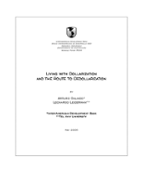Living with Dollarization and the Route to Dedollarization
Date
May 2005
Financial dollarization in Latin America has been growing over time in spite of a major reduction in inflation and a shift toward central bank independence. After discussing the key stylized facts of dollarization and dedollarization in the region, we discuss the risks this process poses to the region. In particular, we explore the validity of concerns about the effectiveness of monetary policy in a dollarized economy and about a loss of seigniorage revenue in such an economy. After concluding that to a large extent these concerns lack empirical support, we focus on the main reason for concern: increased vulnerability due to the dollarization of public and private debt. We emphasize the importance of precautionary/regulatory measures to limit the scope of mismatches originating from liability dollarization, and of developing financial instruments designed to hedge against currency risk. Moreover, we deal with the experience of policies directly aimed at deepening domestic financial markets in local currency assets and in gradually lengthening the maturity of these assets. We find that important lessons from the experience of dedollarization in Israel are of particular interest for Latin America.



